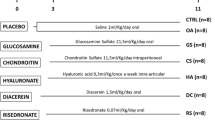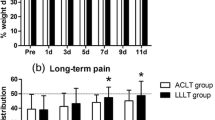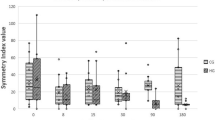Abstract
Intra-articular injections of glucocorticosteroids, including triamcinolone, remain controversial, despite the treatment’s inclusion in the guidelines for the management of patients with large joint osteoarthritis. Only a few trials studied the effect of triamcinolone on joint structure in vivo; however, most of the obtained results cannot be applied to patients with osteoarthritis. To determine the effect of a single, three and six weekly intra-articular injections of triamcinolone acetonide on articular cartilage and other joint structures. Fifteen rabbits were divided into three groups with a single, three, and six weekly intra-articular injections. Intact left knee joint of all rabbits was used as a control group. After euthanasia, a morphometric study of histological preparations of the joints was performed using a random-step morphometric grid by SB Stefanov. A single intra-articular injection had no negative effect on the knee joint morphology. Three weekly drug injections led to edema and microcirculatory disorders of the synovial membrane, minor degenerative, and necrotic changes but did not affect articular cartilage. Six injections with a 1-week interval led to pronounced aseptic destruction of the synovial membrane, slight decrease in cartilaginous lining thickness, and dystrophic-necrotic changes. Single and three weekly intra-articular triamcinolone injections into the rabbit knee joint (total dose equivalent to 120 mg for humans) did not have a chondrotoxic effect. Six weekly injections of triamcinolone (total dose equivalent to 240 mg for humans) led to severe synovial membrane destruction and to minor changes in the articular cartilage without affecting the subchondral bone.



Similar content being viewed by others
References
Chichasova, N. V., Mendel, O. I., & Nasonov, E. L. (2010). Osteoarthritis as a general therapeutic problem. Russian medical journal., 11, 729–734.
Bannuru, R. R., Osani, M. C., Vaysbrot, E. E., Arden, N. K., et al. (2019). OARSI guidelines for the non-surgical management of knee, hip, and polyarticular osteoarthritis. Osteoarthritis and Cartilage., 27(11), 1578–1589. https://doi.org/10.1016/j.joca.2019.06.011
Uson, J., Rodriguez-García, S. C., Castellanos-Moreira, R., et al. (2021). EULAR recommendations for intra-articular therapies. Annals of the Rheumatic Diseases., 80, 1299–1305. https://doi.org/10.1136/annrheumdis-2021-220266
Kolasinski, S. L., Neogi, T., Hochberg, M. C., Oatis, C., et al. (2020). 2019 American College of Rheumatology/Arthritis Foundation Guideline for the Management of Osteoarthritis of the Hand, Hip, and Knee. Arthritis Care and Research, 72(2), 149–162. https://doi.org/10.1002/acr.24131
Moskowitz, R. W., Davis, W., Sammarco, J., & Mast, W. (1970). Chase SW Experimentally induced corticosteroid arthropathy. Arthritis and Rheumatism, 13, 236–243. https://doi.org/10.1002/art.1780130304
Celeste, C., Ionescu, M., Poole, A. R., & Laverty, S. (2005). Repeated intraarticular injections of triamcinolone acetonide alter cartilage matrix metabolism measured by biomarkers in synovial fluid. Journal of Orthopaedic Research, 23, 602–610. https://doi.org/10.1016/j.orthres.2004.10.003
Korzhevsky, D. E. (2005). Brief summary of the basics of histological technique for physicians and histologists (p. 48). Publishing House “Krof”. (in Russian).
Pakht, A.V., Manizer, N.M. (2008). Features of bone tissue processing. Library of the pathologist (scientific and practical journal), 6–11. (in Russian)
Stefanov S.B. Morphometric grid of random step as a means of accelerated measurement of elements of morphogenesis. Cytology. 1974; 6: 785 – 787. Tsitologiya. 1974; 6:785–787.]
Braun, H. J., Wilcox-Fogel, N., Kim, H. J., Pouliot, M. A., et al. (2012). The effect of local anesthetic and corticosteroid combinations on chondrocyte viability. Knee Surgery, Sports Traumatology, Arthroscopy, 20(9), 1689–1695. https://doi.org/10.1007/s00167-011-1728-1
Busse, P., Vater, C., Stiehler, M., Nowotny, J., Kasten, P., Bretschneider, H., Goodman, S. B., Gelinsky, M., & Zwingenberger, S. (2019). Cytotoxicity of drugs injected into joints in orthopaedics. Bone Joint Res., 8, 41–48. https://doi.org/10.1302/2046-3758.82.BJR-2018-0099.R1
Sola, M., Dahners, L., Weinhold, P., van der Horst, A. S., Kallianos, S., & Flood, D. (2015). The viability of chondrocytes after an in vivo injection of local anaesthetic and/or corticosteroid a laboratory study using a rat model. Bone Joint J, 97-B, 933–8. https://doi.org/10.1302/0301-620X.97B7.35398
Raynauld, J. P., Buckland-Wright, C. C., Ward, R., Choquette, D., et al. (2003). Safety and efficacy of long-term intraarticular steroid injections in osteoarthritis of the knee: A randomized, double-blind, placebo-controlled trial. Arthritis Rheum., 48(2), 370–7. https://doi.org/10.1002/art.10777
Cecil, D. L., Johnson, K., Rediske, J., Lotz, M., Schmidt, A. M., & Terkeltaub, R. (2005). Inflammation-induced chondrocyte hypertrophy is driven by receptor for advanced glycation end products. The Journal of Immunology, 175(12), 8296–8302. https://doi.org/10.4049/jimmunol.175.12.8296
Acknowledgements
BNL was supported by the Kazan Federal University Strategic Academic Leadership Program (PRIORITY-2030)
Author information
Authors and Affiliations
Corresponding author
Ethics declarations
Ethical approval
The study was performed in accordance with international and national regulations regarding laboratory animal use and care. This article does not contain any studies with human participants performed by any of the authors.
Conflict of interest
The authors declare no competing interests.
Research Involving Humans and Animals Statement
The study was performed in accordance with international and national regulations regarding laboratory animal use and care. The study was approved by the local ethics committee of Kazan state medical university on 24th of March 2020. This article does not contain any studies with human participants performed by any of the authors.
Informed Consent
None.
Additional information
Publisher's Note
Springer Nature remains neutral with regard to jurisdictional claims in published maps and institutional affiliations.
Rights and permissions
About this article
Cite this article
Nuriakhmetov, A.N., Akhtyamov, I.F., Tsyplakov, D.E. et al. Effect of Triamcinolone Acetonide on Articular Cartilage. BioNanoSci. 12, 496–501 (2022). https://doi.org/10.1007/s12668-022-00978-y
Accepted:
Published:
Issue Date:
DOI: https://doi.org/10.1007/s12668-022-00978-y




